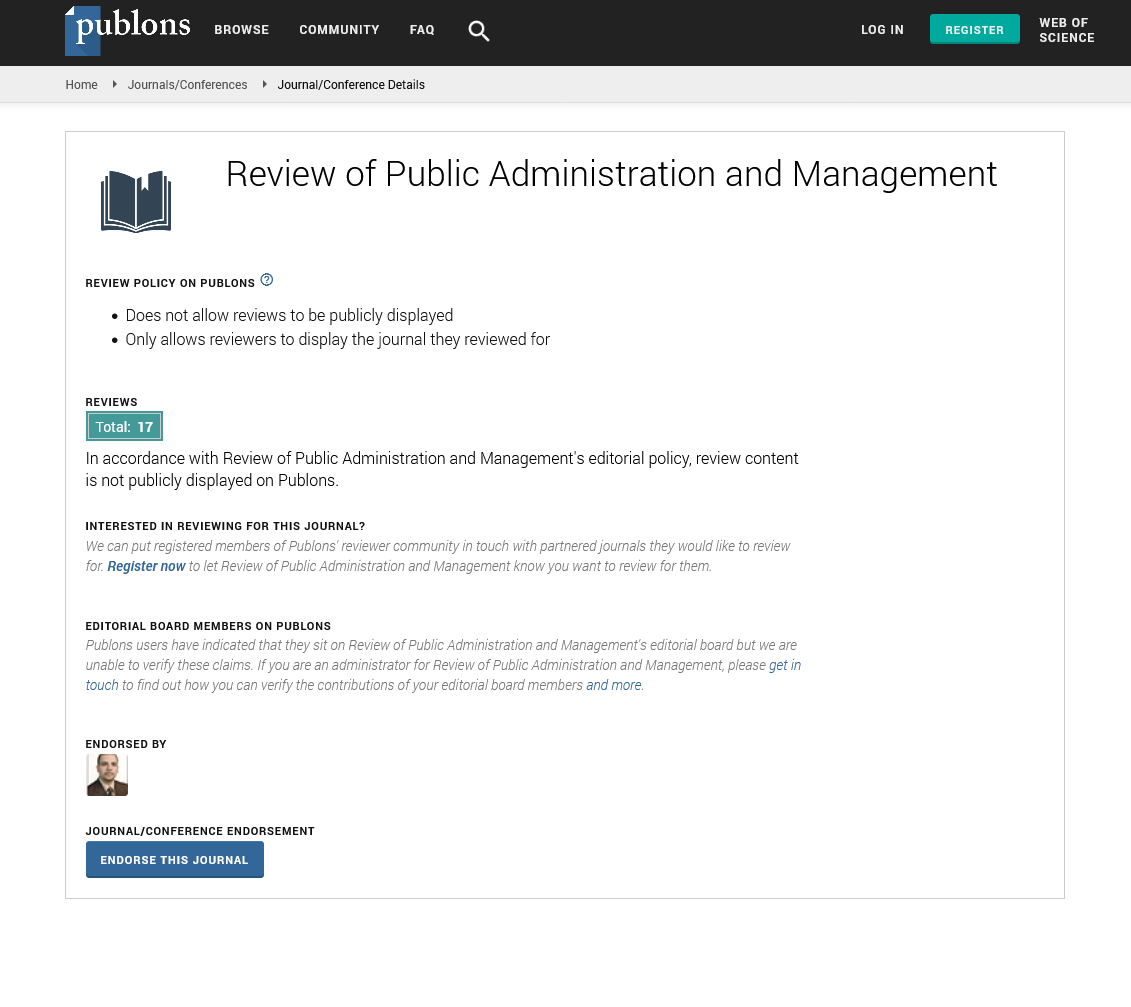Indexed In
- CiteFactor
- RefSeek
- Directory of Research Journal Indexing (DRJI)
- Hamdard University
- EBSCO A-Z
- Scholarsteer
- Publons
- Euro Pub
- Google Scholar
Useful Links
Share This Page
Journal Flyer

Open Access Journals
- Agri and Aquaculture
- Biochemistry
- Bioinformatics & Systems Biology
- Business & Management
- Chemistry
- Clinical Sciences
- Engineering
- Food & Nutrition
- General Science
- Genetics & Molecular Biology
- Immunology & Microbiology
- Medical Sciences
- Neuroscience & Psychology
- Nursing & Health Care
- Pharmaceutical Sciences
Opinion Article - (2025) Volume 13, Issue 2
Public Administration and Environmental Sustainability
Claudia Weber*Received: 02-Jun-2025, Manuscript No. RPAM-25-29756; Editor assigned: 04-Jun-2025, Pre QC No. RPAM-25-29756; Reviewed: 17-Jun-2025, QC No. RPAM-25-29756; Revised: 21-Jun-2025, Manuscript No. RPAM-25-29756; Published: 28-Jun-2025, DOI: 10.35248/2315-7844.25.13.492
Description
Environmental sustainability has emerged as one of the defining challenges of contemporary governance. Public administration plays a decisive role in shaping how societies respond to climate change, biodiversity loss, pollution and the unsustainable use of natural resources. Unlike market actors whose decisions are often driven by profit, public administrations are entrusted with balancing ecological protection, economic stability and social well-being. This responsibility places administrators at the center of efforts to transition societies toward more sustainable futures. Sustainability in the context of public administration extends beyond environmental protection alone. It includes designing policies that secure long-term economic resilience, safeguard human health and preserve natural ecosystems for future generations. Administrators must interpret scientific evidence, translate it into regulations and oversee compliance. This process demands collaboration across multiple levels of government, coordination with international treaties and engagement with civil society and the private sector.
One of the most visible arenas where public administration shapes sustainability is climate policy. Governments worldwide have developed action plans to reduce greenhouse gas emissions, promote renewable energy and encourage energy efficiency. Administrators are responsible for implementing these plans, whether through incentivizing solar panel installation, supporting sustainable transportation networks, or enforcing emission reduction targets. In Germany, for instance, public administrators were instrumental the country’s ambitious transition toward renewable energy sources. This required coordination across ministries, the creation of regulatory frameworks and collaboration with industries to ensure a smooth transition. Environmental sustainability also requires effective regulatory systems. Administrators must establish standards for pollution control, waste management, water quality and land use. Enforcement is a continuous challenge, particularly when industries resist regulation or when resources for monitoring are limited. In countries like Brazil, public administrations face the delicate task of balancing economic development with the protection of the Amazon rainforest. Illegal deforestation, mining and agricultural expansion threaten biodiversity and climate stability, demanding strong enforcement mechanisms. Administrators working in such contexts must resist political and economic pressures while ensuring laws are implemented fairly and consistently.
Sustainable urban planning provides another domain where public administration exerts significant influence. Rapid urbanization across Asia, Africa and Latin America places immense pressure on infrastructure, housing and public services. Administrators are tasked with designing cities that reduce energy consumption, minimize waste and create livable environments for growing populations. Policies supporting green spaces, efficient public transportation and eco-friendly construction practices can significantly reduce environmental footprints. For example, Freiburg in Germany has become a model for sustainable urban planning, with public administrators actively supporting cycling infrastructure, renewable energy integration and environmentally conscious zoning policies. Public administration also mediates the relationship between citizens and sustainability goals. Building public support is essential, as environmental policies often require changes in individual behavior, such as reducing car usage, recycling waste, or conserving energy. Administrators engage in public awareness campaigns, create incentive programs and design participatory decision-making processes that encourage citizen involvement. When citizens feel consulted and informed, they are more likely to support environmental initiatives. This democratic aspect of administration strengthens the legitimacy and effectiveness of sustainability policies.
International cooperation adds another dimension to the responsibilities of public administrations. Environmental challenges rarely respect national borders. Air pollution, water contamination and climate change all have transboundary effects. Administrators must therefore participate in global negotiations and treaties, such as the Paris Agreement, which commits countries to limit global temperature rise. Translating these commitments into national and local actions requires careful coordination between international expectations and domestic realities. Germany’s role in European Union climate frameworks illustrates how administrations integrate regional agreements into national policies. Technology provides opportunities as well as challenges for environmental administration. Advances in renewable energy, data analytics and environmental monitoring tools empower administrators to design more effective policies. Remote sensing satellites, for example, allow real-time tracking of deforestation, while big data can predict energy consumption patterns. However, technology alone is insufficient. Administrators must ensure that innovations are accessible, affordable and integrated into broader policy frameworks. Without appropriate regulation and planning, technological solutions can remain underutilized or even create unintended consequences.
Financing sustainability is another pressing issue. Public administrations must design budgets that allocate resources to environmental initiatives while balancing other priorities such as healthcare, education and infrastructure. Green financing mechanisms, carbon pricing and subsidies for sustainable practices are tools that administrators deploy to mobilize resources. In countries with limited financial capacity, administrators often rely on international aid or partnerships with development agencies to fund sustainability projects. Yet, these arrangements require accountability and transparency to ensure resources are effectively utilized. Environmental justice adds a social dimension to sustainability. Poor and marginalized communities are often the most vulnerable to environmental degradation, facing greater risks from air pollution, contaminated water and extreme weather events. Public administrators must design policies that protect these groups and distribute environmental benefits equitably. For example, ensuring affordable access to clean energy or prioritizing flood defenses in vulnerable neighborhoods can reduce inequality while advancing sustainability goals. Equity-focused approaches strengthen public trust and enhance the resilience of entire societies.
Citation: Weber C (2025). Public Administration and Environmental Sustainability. 13:492.
Copyright: © 2025 Weber C. This is an open-access article distributed under the terms of the Creative Commons Attribution License, which permits unrestricted use, distribution and reproduction in any medium, provided the original author and source are credited.


